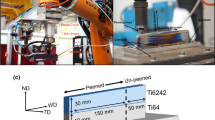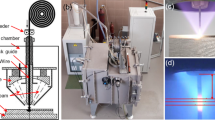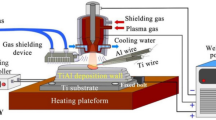Abstract
To address the problems of coarse columnar grains, inhomogeneous microstructure, and anisotropic mechanical properties of Ti-6Al-4V manufactured by wire and arc additive manufacturing (WAAM) and hybrid additive manufacturing with plasma-arc deposition, synchronous microrolling (HDMR) was examined in this study. HDMR leads to significant grain refinement and isotropy improvement. Unrolled additive manufacturing alloys show typical columnar grains, while the microrolled ones show a transition from columnar to equiaxed grains with the fraction depending on the microrolling force. The microrolling-induced formation of equiaxed grains is caused by both dendrite fragmentation and prior β recrystallization in the subsequent deposition. Interestingly, the rolling force required for good grain refinement in HDMR is much lower than that in WAAM with subsequent cold rolling. Microstructure characteristics are present near the grain boundaries due to the recrystallized α lamellae distribution. The width of the basketweave α lamellae decreases with the increasing microrolling force. The yield strength and ultimate tensile strength of HDMR samples increase with a decrease in elongation anisotropy. This study shows that HDMR can effectively refine grains and improve the tensile properties of titanium alloys, providing a broad prospect for the rapid formation of large titanium alloy parts.
Similar content being viewed by others
References
Wang J, Lin X, Wang J, et al. Grain morphology evolution and texture characterization of wire and arc additive manufactured Ti-6Al-4V. J Alloys Compd, 2018, 2018: 768–97
Kobryn P A, Moore E H, Semiatin S L. The effect of laser power and traverse speed on microstructure, porosity, and build height in laser-deposited Ti-6Al-4V. Scripta Mater, 2000, 2000: 43–299
Huang W, Lin X. Research progress in laser solid forming of high-performance metallic components at the state key laboratory of solidification processing of China. 3D Printing Additive Manuf, 2014, 2014: 1–156
Wang J, Lin X, Wang M, et al. Effects of subtransus heat treatments on microstructure features and mechanical properties of wire and arc additive manufactured Ti-6Al-4V alloy. Mater Sci Eng-A, 2020, 2020: 776
Song Y A, Park S, Choi D, et al. 3D welding and milling: Part I—A direct approach for freeform fabrication of metallic prototypes. Int J Machine Tools Manuf, 2005, 2005: 45–1057
Xia M, Liu A, Hou Z, et al. Microstructure growth behavior and its evolution mechanism during laser additive manufacture of in-situ reinforced (TiB+TiC)/Ti composite. J Alloys Compd, 2017, 2017: 728–436
Wang F, Williams S, Colegrove P, et al. Microstructure and mechanical properties of wire and arc additive manufactured Ti-6Al-4V. Metall Mat Trans A, 2013, 2013: 44–968
Baufeld B, Biest O V, Gault R. Additive manufacturing of Ti-6Al-4V components by shaped metal deposition: Microstructure and mechanical properties. Mater Des, 2010, 31: S106–S111
Ahmed T, Rack H J. Phase transformations during cooling in α+β titanium alloys. Mater Sci Eng-A, 1998, 1998: 243–206
Martina F, Mehnen J, Williams S W, et al. Investigation of the benefits of plasma deposition for the additive layer manufacture of Ti-6Al-4V. J Mater Processing Tech, 2012, 2012: 212–1377
Wang J, Lin X, Li J, et al. A study on obtaining equiaxed prior-β grains of wire and arc additive manufactured Ti-6Al-4V. Mater Sci Eng-A, 2020, 2020: 772
Brandl E, Schoberth A, Leyens C. Morphology, microstructure, and hardness of titanium (Ti-6Al-4V) blocks deposited by wire-feed additive layer manufacturing (ALM). Mater Sci Eng-A, 2012, 2012: 532–295
Zhang H O, Wang R, Liang L, et al. HDMR technology for the aircraft metal part. Rapid Prototy J, 2016, 2016: 22–857
Donoghue J, Antonysamy A A, Martina F, et al. The effectiveness of combining rolling deformation with wire-arc additive manufacture on β-grain refinement and texture modification in Ti-6Al-4V. Mater Charact, 2016, 2016: 114–103
Colegrove P A, Donoghue J, Martina F, et al. Application of bulk deformation methods for microstructural and material property improvement and residual stress and distortion control in additively manufactured components. Scripta Mater, 2017, 2017: 135–111
Martina F, Colegrove P A, Williams S W, et al. Microstructure of interpass rolled wire+arc additive manufacturing Ti-6Al-4V components. Metall Mat Trans A, 2015, 2015: 46–6103
McAndrew A R, Alvarez Rosales M, Colegrove P A, et al. Interpass rolling of Ti-6Al-4V wire + arc additively manufactured features for microstructural refinement. Additive Manufacturing, 2018, 2018: 21–340
Zhang H, Wang X, Wang G, et al. Hybrid direct manufacturing method of metallic parts using deposition and micro continuous rolling. Rapid Prototyping J, 2013, 2013: 19–387
Fu Y, Zhang H, Wang G, et al. Investigation of mechanical properties for hybrid deposition and micro-rolling of bainite steel. J Mater Processing Tech, 2017, 2017: 250–220
Lin J J, Lv Y H, Liu Y X, et al. Microstructural evolution and mechanical properties of Ti-6Al-4V wall deposited by pulsed plasma arc additive manufacturing. Mater Des, 2016, 2016: 102–30
Bermingham M J, McDonald S D, Dargusch M S, et al. Grain-refinement mechanisms in titanium alloys. J Mater Res, 2008, 2008: 23–97
Easton M A, StJohn D H. A model of grain refinement incorporating alloy constitution and potency of heterogeneous nucleant particles. Acta Mater, 2001, 2001: 49–1867
Bermingham M J, McDonald S D, Dargusch M S, et al. The mechanism of grain refinement of titanium by silicon. Scripta Mater, 2008, 2008: 58–1050
Lin X, Yue T M, Yang H O, et al. Solidification behavior and the evolution of phase in laser rapid forming of graded Ti6Al4V-Re-ne88DT alloy. Metall Mat Trans A, 2007, 2007: 38–127
Xie Y, Gong M, Zhang R, et al. Grain boundary discontinuity and performance improvement mechanism of wire arc additive manufactured Ti-6Al-4V. J Alloys Compd, 2021, 2021: 869
Carroll B E, Palmer T A, Beese A M. Anisotropic tensile behavior of Ti-6Al-4V components fabricated with directed energy deposition additive manufacturing. Acta Mater, 2015, 2015: 87–309
Lütjering G. Influence of processing on microstructure and mechanical properties of (α+β) titanium alloys. Mater Sci Eng-A, 1998, 1998: 243–32
Author information
Authors and Affiliations
Corresponding authors
Additional information
This work was supported by the National Natural Science Foundation of China (Grant No. 51971099), the Wuhan Science and Technology Plan Project (Grant No. 201903070301151), and the Analytical and Testing Center, HUST.
Rights and permissions
About this article
Cite this article
Cheng, K., Zhang, M., Song, H. et al. Additive manufacturing of Ti-6Al-4V alloy by hybrid plasma-arc deposition and microrolling: Grain morphology, microstructure, and tensile properties. Sci. China Technol. Sci. 65, 849–857 (2022). https://doi.org/10.1007/s11431-021-1991-7
Received:
Accepted:
Published:
Issue Date:
DOI: https://doi.org/10.1007/s11431-021-1991-7




